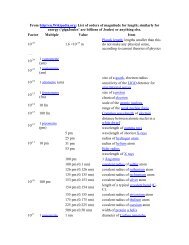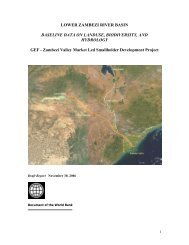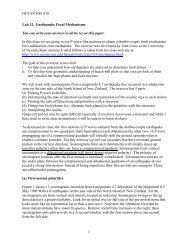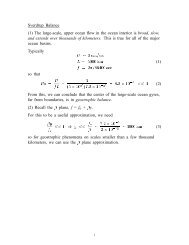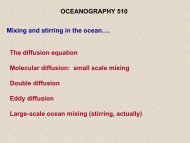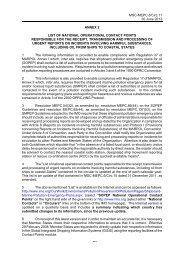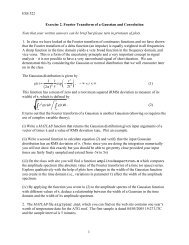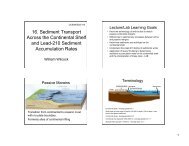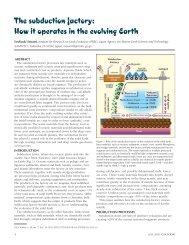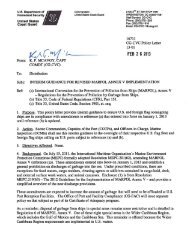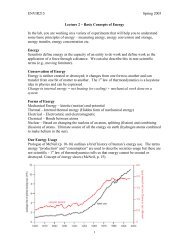2012 Seafloor Geodesy in Cascadia - William Wilcock - University of ...
2012 Seafloor Geodesy in Cascadia - William Wilcock - University of ...
2012 Seafloor Geodesy in Cascadia - William Wilcock - University of ...
Create successful ePaper yourself
Turn your PDF publications into a flip-book with our unique Google optimized e-Paper software.
Goals <strong>of</strong> the Workshop <br />
Recent devastat<strong>in</strong>g megathrust earthquakes <strong>of</strong>f Sumatra, Chile and Japan have further <br />
raised awareness <strong>of</strong> the hazard posed by subduction zones and the <strong>in</strong>evitability <strong>of</strong> a <br />
comparable earthquake along the coast <strong>of</strong> the Pacific Northwest. This meet<strong>in</strong>g arose from <br />
several conversations at the <strong>University</strong> <strong>of</strong> Wash<strong>in</strong>gton that explored the potential synergies <br />
between land-‐based seismic and geodetic monitor<strong>in</strong>g <strong>in</strong> the Pacific Northwest and ongo<strong>in</strong>g <br />
efforts to establish cabled observatories <strong>of</strong>f the coast <strong>of</strong> the Pacific Northwest. Both the <br />
NEPTUNE Canada and Regional Scale Nodes cabled observatories are support<strong>in</strong>g networks <br />
<strong>of</strong> seafloor seismometers. Their <strong>in</strong>stallation is a result <strong>of</strong> extensive discussions and <br />
documentation with<strong>in</strong> the scientific community <strong>of</strong> their scientific worth. In contrast, <br />
relatively little attention has been given to the rationale for <strong>of</strong>fshore geodetic observations, <br />
despite their potential importance for understand<strong>in</strong>g the basic science and hazard <strong>of</strong> the <br />
<strong>Cascadia</strong> subduction zone. <br />
For this reason John Delaney, the Director <strong>of</strong> Regional Scale Nodes Program, and John <br />
Vidale, the Director <strong>of</strong> the Pacific Northwest Seismic Network, provided <strong>in</strong>ternal <strong>University</strong> <br />
<strong>of</strong> Wash<strong>in</strong>gton funds to host a small meet<strong>in</strong>g <strong>of</strong> twenty participants to explore the potential <br />
<strong>of</strong> seafloor geodesy <strong>in</strong> our region. As a result <strong>of</strong> community <strong>in</strong>terest, the size <strong>of</strong> the meet<strong>in</strong>g <br />
grew significantly and on June 11-‐12, <strong>2012</strong>, about fifty scientists and eng<strong>in</strong>eers (Appendix <br />
A), <strong>in</strong>clud<strong>in</strong>g twenty from out <strong>of</strong> town, met for a day and a half on the <strong>University</strong> <strong>of</strong> <br />
Wash<strong>in</strong>gton campus. The meet<strong>in</strong>g agenda (Appendix B) was designed to address three <br />
goals: <br />
1. Develop<strong>in</strong>g the scientific rationale for mak<strong>in</strong>g seafloor geodetic observations <strong>of</strong> <br />
<strong>Cascadia</strong> subduction zone. <br />
2. Discuss<strong>in</strong>g what is best to measure, where to measure it and how. <br />
3. Explor<strong>in</strong>g short-‐term and long-‐term plans for how to build seafloor geodesy upon <br />
current efforts. <br />
This report provides a short summary <strong>of</strong> the meet<strong>in</strong>g. <br />
<strong>Cascadia</strong> Subduction Zone <br />
The <strong>Cascadia</strong> subduction zone extends 1100 km from Cape Mendoc<strong>in</strong>o, California to <br />
northern Vancouver Island and marks the boundary along which the small Juan de Fuca <br />
oceanic plate subducts beneath North America (Figure 1). Convergence occurs <strong>in</strong> a <br />
northeast direction at modest rates rang<strong>in</strong>g from 30 mm/yr <strong>of</strong>f northern California to over <br />
40 mm/yr <strong>of</strong>f Vancouver Island. Because the subduct<strong>in</strong>g Juan de Fuca plate is young (5-‐10 <br />
Ma) and thus warm, the locked zone that fails <strong>in</strong> megathrust earthquakes is relatively <br />
shallow and lies almost exclusively <strong>of</strong>fshore. The Juan de Fuca plate is blanketed by up to <br />
4-‐5 km <strong>of</strong> glacial sediments that bury the trench and reduce seafloor depths. Most <strong>of</strong> the <br />
sediments on the <strong>in</strong>com<strong>in</strong>g plate are scraped <strong>of</strong>f to form an active accretionary prism that <br />
extends shoreward from a sharp deformation front and lies outboard <strong>of</strong> older, accreted <br />
terranes that form the rock framework <strong>of</strong> the marg<strong>in</strong>. An active volcanic arc extends the <br />
full length <strong>of</strong> the subduction zone. <br />
5



